Abstract
Although the mechanisms of human immunodeficiency virus (HIV) neuroinvasion, neuronal injury, and subsequent development of HIV-1-associated AIDS dementia complex are not fully understood, a correlation between monocyte/macrophage infiltrates in the brain and neurological disease exists. In light of the many potential roles that chemokines and chemokine receptors may play in HIV neuropathogenesis, we sought to describe their pattern of expression in the SIV-infected rhesus macaque model of HIV encephalitis. We previously demonstrated elevated expression of the chemokines macrophage inflammatory protein (MIP)-1alpha, MIP-1beta, RANTES, and interferon-inducible protein (IP)-10 in brain of macaque monkeys with SIV encephalitis. In this study, we demonstrate that the corresponding chemokine receptors CCR3, CCR5, CXCR3, and CXCR4 are expressed in perivascular infiltrates in these same tissues. In addition, we detected CCR3, CCR5, and CXCR4 on subpopulations of large hippocampal and neocortical pyramidal neurons and on glial cells in both normal and encephalitic brain. These findings suggest that multiple chemokines and their receptors contribute to monocyte and lymphocyte recruitment to the brain in SIV encephalitis. Furthermore, the expression of known HIV/SIV co-receptors on neurons suggests a possible mechanism whereby HIV or SIV can directly interact with these cells, disrupting their normal physiological function and contributing to the pathogenesis of AIDS dementia complex.
Full text
PDF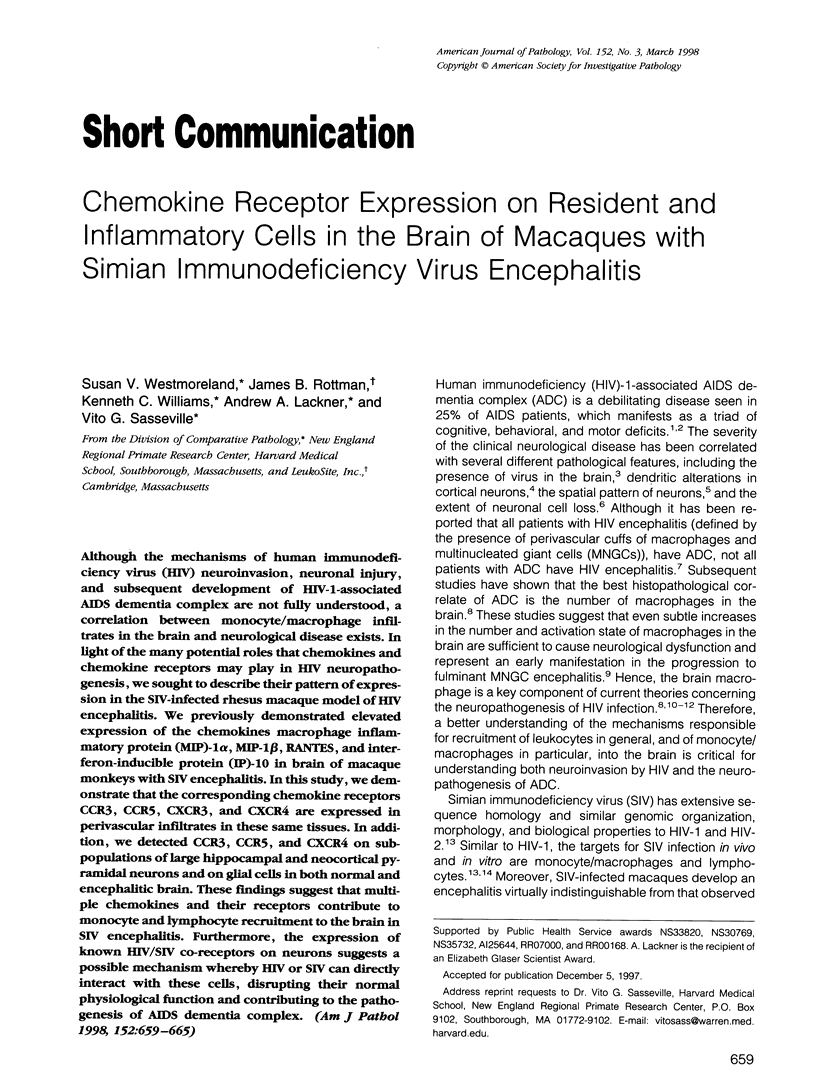
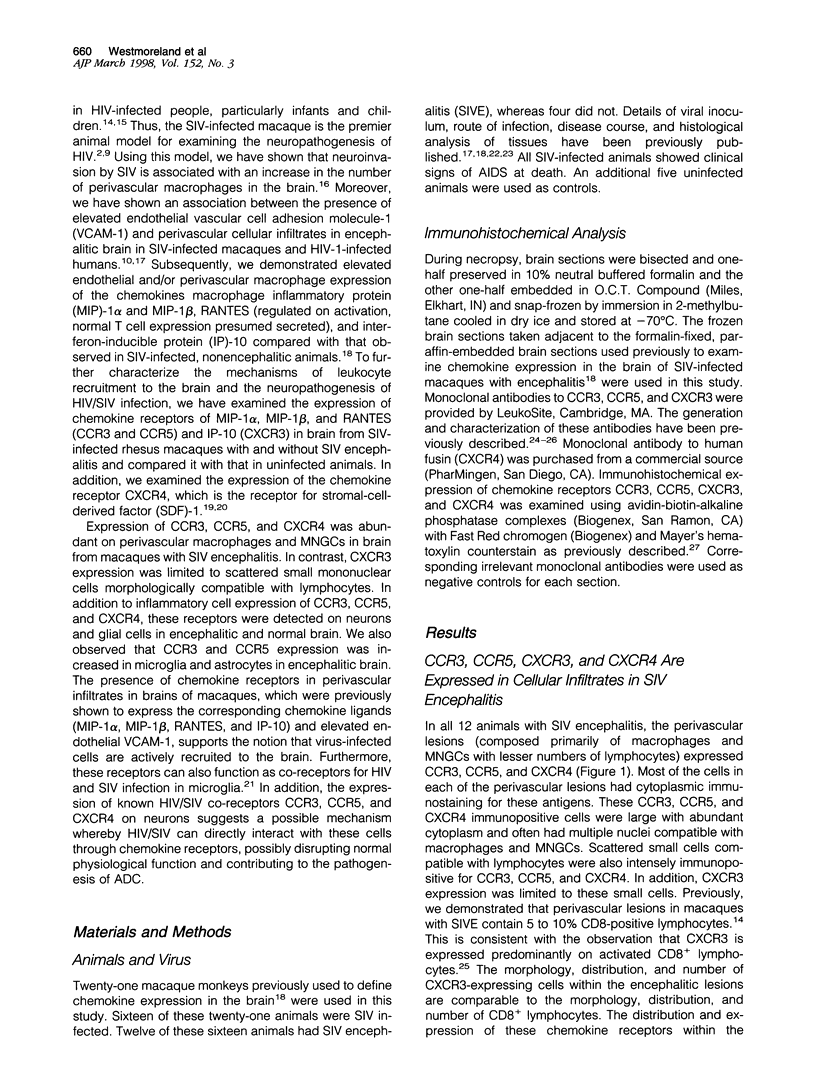
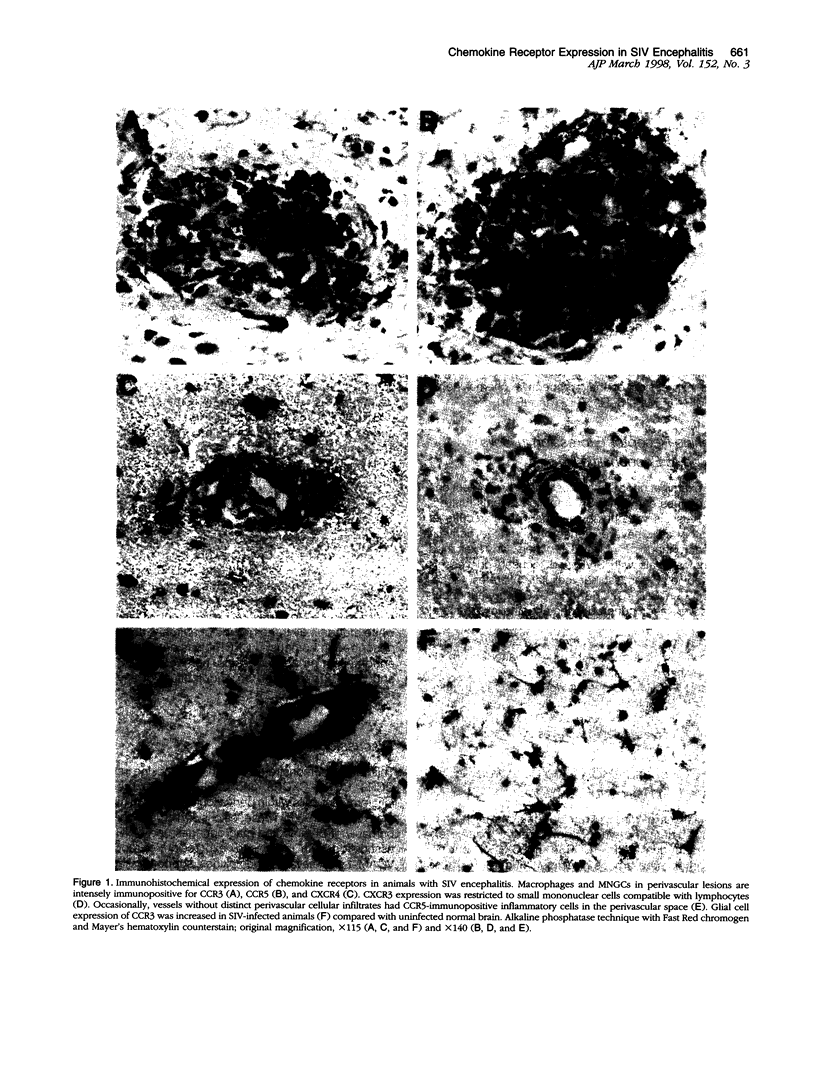
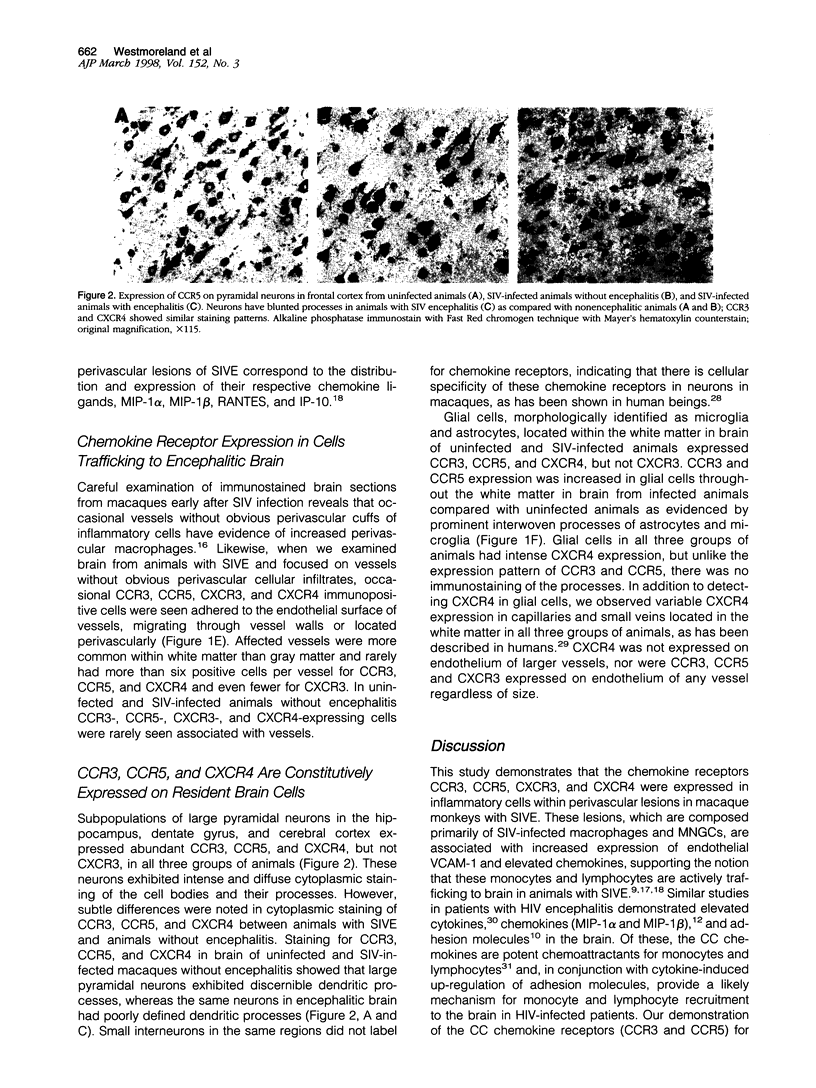
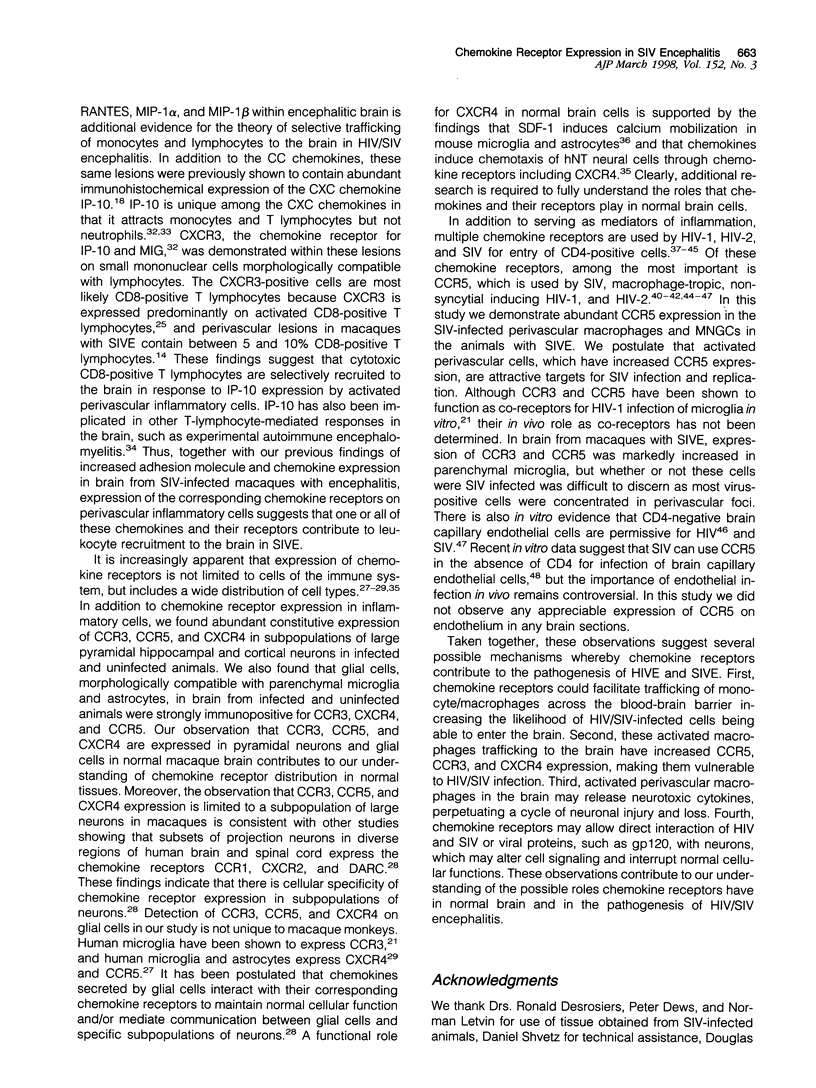
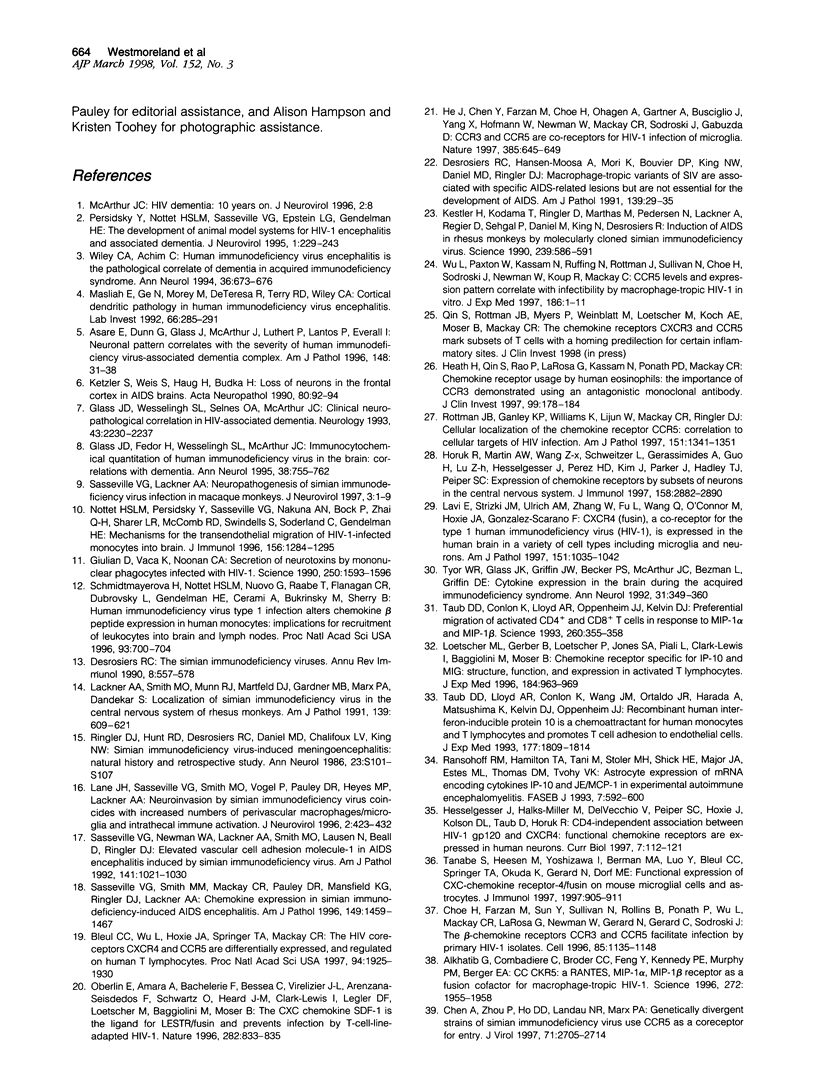
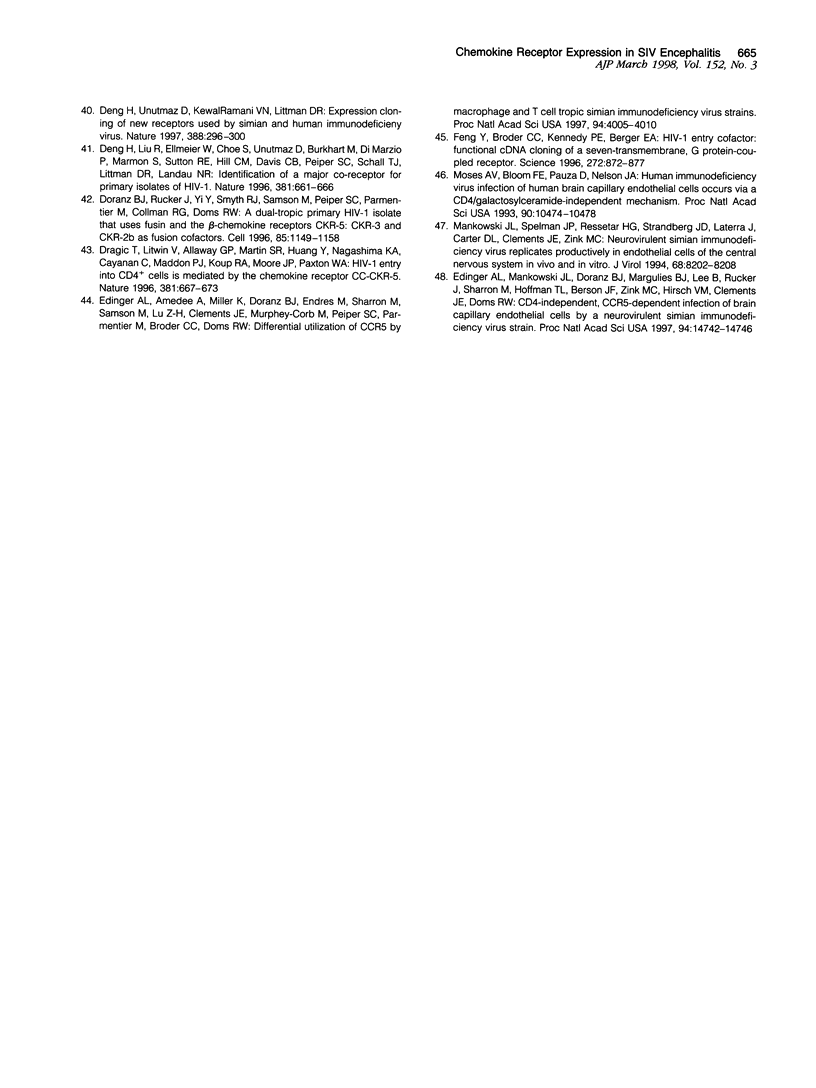
Images in this article
Selected References
These references are in PubMed. This may not be the complete list of references from this article.
- Alkhatib G., Combadiere C., Broder C. C., Feng Y., Kennedy P. E., Murphy P. M., Berger E. A. CC CKR5: a RANTES, MIP-1alpha, MIP-1beta receptor as a fusion cofactor for macrophage-tropic HIV-1. Science. 1996 Jun 28;272(5270):1955–1958. doi: 10.1126/science.272.5270.1955. [DOI] [PubMed] [Google Scholar]
- Asare E., Dunn G., Glass J., McArthur J., Luthert P., Lantos P., Everall I. Neuronal pattern correlates with the severity of human immunodeficiency virus-associated dementia complex. Usefulness of spatial pattern analysis in clinicopathological studies. Am J Pathol. 1996 Jan;148(1):31–38. [PMC free article] [PubMed] [Google Scholar]
- Bleul C. C., Wu L., Hoxie J. A., Springer T. A., Mackay C. R. The HIV coreceptors CXCR4 and CCR5 are differentially expressed and regulated on human T lymphocytes. Proc Natl Acad Sci U S A. 1997 Mar 4;94(5):1925–1930. doi: 10.1073/pnas.94.5.1925. [DOI] [PMC free article] [PubMed] [Google Scholar]
- Chen Z., Zhou P., Ho D. D., Landau N. R., Marx P. A. Genetically divergent strains of simian immunodeficiency virus use CCR5 as a coreceptor for entry. J Virol. 1997 Apr;71(4):2705–2714. doi: 10.1128/jvi.71.4.2705-2714.1997. [DOI] [PMC free article] [PubMed] [Google Scholar]
- Choe H., Farzan M., Sun Y., Sullivan N., Rollins B., Ponath P. D., Wu L., Mackay C. R., LaRosa G., Newman W. The beta-chemokine receptors CCR3 and CCR5 facilitate infection by primary HIV-1 isolates. Cell. 1996 Jun 28;85(7):1135–1148. doi: 10.1016/s0092-8674(00)81313-6. [DOI] [PubMed] [Google Scholar]
- Deng H. K., Unutmaz D., KewalRamani V. N., Littman D. R. Expression cloning of new receptors used by simian and human immunodeficiency viruses. Nature. 1997 Jul 17;388(6639):296–300. doi: 10.1038/40894. [DOI] [PubMed] [Google Scholar]
- Deng H., Liu R., Ellmeier W., Choe S., Unutmaz D., Burkhart M., Di Marzio P., Marmon S., Sutton R. E., Hill C. M. Identification of a major co-receptor for primary isolates of HIV-1. Nature. 1996 Jun 20;381(6584):661–666. doi: 10.1038/381661a0. [DOI] [PubMed] [Google Scholar]
- Desrosiers R. C., Hansen-Moosa A., Mori K., Bouvier D. P., King N. W., Daniel M. D., Ringler D. J. Macrophage-tropic variants of SIV are associated with specific AIDS-related lesions but are not essential for the development of AIDS. Am J Pathol. 1991 Jul;139(1):29–35. [PMC free article] [PubMed] [Google Scholar]
- Desrosiers R. C. The simian immunodeficiency viruses. Annu Rev Immunol. 1990;8:557–578. doi: 10.1146/annurev.iy.08.040190.003013. [DOI] [PubMed] [Google Scholar]
- Doranz B. J., Rucker J., Yi Y., Smyth R. J., Samson M., Peiper S. C., Parmentier M., Collman R. G., Doms R. W. A dual-tropic primary HIV-1 isolate that uses fusin and the beta-chemokine receptors CKR-5, CKR-3, and CKR-2b as fusion cofactors. Cell. 1996 Jun 28;85(7):1149–1158. doi: 10.1016/s0092-8674(00)81314-8. [DOI] [PubMed] [Google Scholar]
- Dragic T., Litwin V., Allaway G. P., Martin S. R., Huang Y., Nagashima K. A., Cayanan C., Maddon P. J., Koup R. A., Moore J. P. HIV-1 entry into CD4+ cells is mediated by the chemokine receptor CC-CKR-5. Nature. 1996 Jun 20;381(6584):667–673. doi: 10.1038/381667a0. [DOI] [PubMed] [Google Scholar]
- Edinger A. L., Amedee A., Miller K., Doranz B. J., Endres M., Sharron M., Samson M., Lu Z. H., Clements J. E., Murphey-Corb M. Differential utilization of CCR5 by macrophage and T cell tropic simian immunodeficiency virus strains. Proc Natl Acad Sci U S A. 1997 Apr 15;94(8):4005–4010. doi: 10.1073/pnas.94.8.4005. [DOI] [PMC free article] [PubMed] [Google Scholar]
- Edinger A. L., Mankowski J. L., Doranz B. J., Margulies B. J., Lee B., Rucker J., Sharron M., Hoffman T. L., Berson J. F., Zink M. C. CD4-independent, CCR5-dependent infection of brain capillary endothelial cells by a neurovirulent simian immunodeficiency virus strain. Proc Natl Acad Sci U S A. 1997 Dec 23;94(26):14742–14747. doi: 10.1073/pnas.94.26.14742. [DOI] [PMC free article] [PubMed] [Google Scholar]
- Feng Y., Broder C. C., Kennedy P. E., Berger E. A. HIV-1 entry cofactor: functional cDNA cloning of a seven-transmembrane, G protein-coupled receptor. Science. 1996 May 10;272(5263):872–877. doi: 10.1126/science.272.5263.872. [DOI] [PubMed] [Google Scholar]
- Giulian D., Vaca K., Noonan C. A. Secretion of neurotoxins by mononuclear phagocytes infected with HIV-1. Science. 1990 Dec 14;250(4987):1593–1596. doi: 10.1126/science.2148832. [DOI] [PubMed] [Google Scholar]
- Glass J. D., Fedor H., Wesselingh S. L., McArthur J. C. Immunocytochemical quantitation of human immunodeficiency virus in the brain: correlations with dementia. Ann Neurol. 1995 Nov;38(5):755–762. doi: 10.1002/ana.410380510. [DOI] [PubMed] [Google Scholar]
- Glass J. D., Wesselingh S. L., Selnes O. A., McArthur J. C. Clinical-neuropathologic correlation in HIV-associated dementia. Neurology. 1993 Nov;43(11):2230–2237. doi: 10.1212/wnl.43.11.2230. [DOI] [PubMed] [Google Scholar]
- He J., Chen Y., Farzan M., Choe H., Ohagen A., Gartner S., Busciglio J., Yang X., Hofmann W., Newman W. CCR3 and CCR5 are co-receptors for HIV-1 infection of microglia. Nature. 1997 Feb 13;385(6617):645–649. doi: 10.1038/385645a0. [DOI] [PubMed] [Google Scholar]
- Heath H., Qin S., Rao P., Wu L., LaRosa G., Kassam N., Ponath P. D., Mackay C. R. Chemokine receptor usage by human eosinophils. The importance of CCR3 demonstrated using an antagonistic monoclonal antibody. J Clin Invest. 1997 Jan 15;99(2):178–184. doi: 10.1172/JCI119145. [DOI] [PMC free article] [PubMed] [Google Scholar]
- Hesselgesser J., Halks-Miller M., DelVecchio V., Peiper S. C., Hoxie J., Kolson D. L., Taub D., Horuk R. CD4-independent association between HIV-1 gp120 and CXCR4: functional chemokine receptors are expressed in human neurons. Curr Biol. 1997 Feb 1;7(2):112–121. doi: 10.1016/s0960-9822(06)00055-8. [DOI] [PubMed] [Google Scholar]
- Horuk R., Martin A. W., Wang Z., Schweitzer L., Gerassimides A., Guo H., Lu Z., Hesselgesser J., Perez H. D., Kim J. Expression of chemokine receptors by subsets of neurons in the central nervous system. J Immunol. 1997 Mar 15;158(6):2882–2890. [PubMed] [Google Scholar]
- Johnson R. P. Upregulation of Fas ligand by simian immunodeficiency virus - a nef-arious mechanism of immune evasion? J Exp Med. 1997 Jul 7;186(1):1–5. doi: 10.1084/jem.186.1.1. [DOI] [PMC free article] [PubMed] [Google Scholar]
- Ketzler S., Weis S., Haug H., Budka H. Loss of neurons in the frontal cortex in AIDS brains. Acta Neuropathol. 1990;80(1):92–94. doi: 10.1007/BF00294228. [DOI] [PubMed] [Google Scholar]
- Lackner A. A., Smith M. O., Munn R. J., Martfeld D. J., Gardner M. B., Marx P. A., Dandekar S. Localization of simian immunodeficiency virus in the central nervous system of rhesus monkeys. Am J Pathol. 1991 Sep;139(3):609–621. [PMC free article] [PubMed] [Google Scholar]
- Lane J. H., Sasseville V. G., Smith M. O., Vogel P., Pauley D. R., Heyes M. P., Lackner A. A. Neuroinvasion by simian immunodeficiency virus coincides with increased numbers of perivascular macrophages/microglia and intrathecal immune activation. J Neurovirol. 1996 Dec;2(6):423–432. doi: 10.3109/13550289609146909. [DOI] [PubMed] [Google Scholar]
- Lavi E., Strizki J. M., Ulrich A. M., Zhang W., Fu L., Wang Q., O'Connor M., Hoxie J. A., González-Scarano F. CXCR-4 (Fusin), a co-receptor for the type 1 human immunodeficiency virus (HIV-1), is expressed in the human brain in a variety of cell types, including microglia and neurons. Am J Pathol. 1997 Oct;151(4):1035–1042. [PMC free article] [PubMed] [Google Scholar]
- Loetscher M., Gerber B., Loetscher P., Jones S. A., Piali L., Clark-Lewis I., Baggiolini M., Moser B. Chemokine receptor specific for IP10 and mig: structure, function, and expression in activated T-lymphocytes. J Exp Med. 1996 Sep 1;184(3):963–969. doi: 10.1084/jem.184.3.963. [DOI] [PMC free article] [PubMed] [Google Scholar]
- Mankowski J. L., Spelman J. P., Ressetar H. G., Strandberg J. D., Laterra J., Carter D. L., Clements J. E., Zink M. C. Neurovirulent simian immunodeficiency virus replicates productively in endothelial cells of the central nervous system in vivo and in vitro. J Virol. 1994 Dec;68(12):8202–8208. doi: 10.1128/jvi.68.12.8202-8208.1994. [DOI] [PMC free article] [PubMed] [Google Scholar]
- Masliah E., Ge N., Morey M., DeTeresa R., Terry R. D., Wiley C. A. Cortical dendritic pathology in human immunodeficiency virus encephalitis. Lab Invest. 1992 Mar;66(3):285–291. [PubMed] [Google Scholar]
- Moses A. V., Bloom F. E., Pauza C. D., Nelson J. A. Human immunodeficiency virus infection of human brain capillary endothelial cells occurs via a CD4/galactosylceramide-independent mechanism. Proc Natl Acad Sci U S A. 1993 Nov 15;90(22):10474–10478. doi: 10.1073/pnas.90.22.10474. [DOI] [PMC free article] [PubMed] [Google Scholar]
- Nottet H. S., Persidsky Y., Sasseville V. G., Nukuna A. N., Bock P., Zhai Q. H., Sharer L. R., McComb R. D., Swindells S., Soderland C. Mechanisms for the transendothelial migration of HIV-1-infected monocytes into brain. J Immunol. 1996 Feb 1;156(3):1284–1295. [PubMed] [Google Scholar]
- Oberlin E., Amara A., Bachelerie F., Bessia C., Virelizier J. L., Arenzana-Seisdedos F., Schwartz O., Heard J. M., Clark-Lewis I., Legler D. F. The CXC chemokine SDF-1 is the ligand for LESTR/fusin and prevents infection by T-cell-line-adapted HIV-1. Nature. 1996 Aug 29;382(6594):833–835. doi: 10.1038/382833a0. [DOI] [PubMed] [Google Scholar]
- Persidsky Y., Nottet H. S., Sasseville V. G., Epstein L. G., Gendelman H. E. The development of animal model systems for HIV-1 encephalitis and its associated dementia. J Neurovirol. 1995 Sep;1(3-4):229–243. doi: 10.3109/13550289509114019. [DOI] [PubMed] [Google Scholar]
- Ransohoff R. M., Hamilton T. A., Tani M., Stoler M. H., Shick H. E., Major J. A., Estes M. L., Thomas D. M., Tuohy V. K. Astrocyte expression of mRNA encoding cytokines IP-10 and JE/MCP-1 in experimental autoimmune encephalomyelitis. FASEB J. 1993 Apr 1;7(6):592–600. doi: 10.1096/fasebj.7.6.8472896. [DOI] [PubMed] [Google Scholar]
- Ringler D. J., Hunt R. D., Desrosiers R. C., Daniel M. D., Chalifoux L. V., King N. W. Simian immunodeficiency virus-induced meningoencephalitis: natural history and retrospective study. Ann Neurol. 1988;23 (Suppl):S101–S107. doi: 10.1002/ana.410230726. [DOI] [PubMed] [Google Scholar]
- Rottman J. B., Ganley K. P., Williams K., Wu L., Mackay C. R., Ringler D. J. Cellular localization of the chemokine receptor CCR5. Correlation to cellular targets of HIV-1 infection. Am J Pathol. 1997 Nov;151(5):1341–1351. [PMC free article] [PubMed] [Google Scholar]
- Sasseville V. G., Lackner A. A. Neuropathogenesis of simian immunodeficiency virus infection in macaque monkeys. J Neurovirol. 1997 Feb;3(1):1–9. doi: 10.3109/13550289709015787. [DOI] [PubMed] [Google Scholar]
- Sasseville V. G., Newman W. A., Lackner A. A., Smith M. O., Lausen N. C., Beall D., Ringler D. J. Elevated vascular cell adhesion molecule-1 in AIDS encephalitis induced by simian immunodeficiency virus. Am J Pathol. 1992 Nov;141(5):1021–1030. [PMC free article] [PubMed] [Google Scholar]
- Sasseville V. G., Smith M. M., Mackay C. R., Pauley D. R., Mansfield K. G., Ringler D. J., Lackner A. A. Chemokine expression in simian immunodeficiency virus-induced AIDS encephalitis. Am J Pathol. 1996 Nov;149(5):1459–1467. [PMC free article] [PubMed] [Google Scholar]
- Schmidtmayerova H., Nottet H. S., Nuovo G., Raabe T., Flanagan C. R., Dubrovsky L., Gendelman H. E., Cerami A., Bukrinsky M., Sherry B. Human immunodeficiency virus type 1 infection alters chemokine beta peptide expression in human monocytes: implications for recruitment of leukocytes into brain and lymph nodes. Proc Natl Acad Sci U S A. 1996 Jan 23;93(2):700–704. doi: 10.1073/pnas.93.2.700. [DOI] [PMC free article] [PubMed] [Google Scholar]
- Tanabe S., Heesen M., Yoshizawa I., Berman M. A., Luo Y., Bleul C. C., Springer T. A., Okuda K., Gerard N., Dorf M. E. Functional expression of the CXC-chemokine receptor-4/fusin on mouse microglial cells and astrocytes. J Immunol. 1997 Jul 15;159(2):905–911. [PubMed] [Google Scholar]
- Taub D. D., Conlon K., Lloyd A. R., Oppenheim J. J., Kelvin D. J. Preferential migration of activated CD4+ and CD8+ T cells in response to MIP-1 alpha and MIP-1 beta. Science. 1993 Apr 16;260(5106):355–358. doi: 10.1126/science.7682337. [DOI] [PubMed] [Google Scholar]
- Taub D. D., Lloyd A. R., Conlon K., Wang J. M., Ortaldo J. R., Harada A., Matsushima K., Kelvin D. J., Oppenheim J. J. Recombinant human interferon-inducible protein 10 is a chemoattractant for human monocytes and T lymphocytes and promotes T cell adhesion to endothelial cells. J Exp Med. 1993 Jun 1;177(6):1809–1814. doi: 10.1084/jem.177.6.1809. [DOI] [PMC free article] [PubMed] [Google Scholar]
- Tyor W. R., Glass J. D., Griffin J. W., Becker P. S., McArthur J. C., Bezman L., Griffin D. E. Cytokine expression in the brain during the acquired immunodeficiency syndrome. Ann Neurol. 1992 Apr;31(4):349–360. doi: 10.1002/ana.410310402. [DOI] [PubMed] [Google Scholar]
- Wiley C. A., Achim C. Human immunodeficiency virus encephalitis is the pathological correlate of dementia in acquired immunodeficiency syndrome. Ann Neurol. 1994 Oct;36(4):673–676. doi: 10.1002/ana.410360422. [DOI] [PubMed] [Google Scholar]




